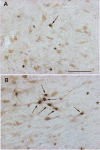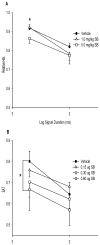Orexin/hypocretin modulation of the basal forebrain cholinergic system: Role in attention
- PMID: 19699722
- PMCID: PMC2819645
- DOI: 10.1016/j.brainres.2009.08.046
Orexin/hypocretin modulation of the basal forebrain cholinergic system: Role in attention
Abstract
The basal forebrain cholinergic system (BFCS) plays a role in several aspects of attentional function. Activation of this system by different afferent inputs is likely to influence how attentional resources are allocated. While it has been recognized for some time that the hypothalamus is a significant source of projections to the basal forebrain, the phenotype(s) of these inputs and the conditions under which their regulation of the BFCS becomes functionally relevant are still unclear. The cell bodies of neurons expressing orexin/hypocretin neuropeptides are restricted to the lateral hypothalamus and contiguous perifornical area but have widespread projections, including to the basal forebrain. Orexin fibers and both orexin receptor subtypes are distributed in cholinergic parts of the basal forebrain, where application of orexin peptides increases cell activity and cortical acetylcholine release. Furthermore, disruption of orexin signaling in the basal forebrain impairs the cholinergic response to an appetitive stimulus. In this review, we propose that orexin inputs to the BFCS form an anatomical substrate for links between arousal and attention, and that these interactions might be particularly important as a means by which interoceptive cues bias allocation of attentional resources toward related exteroceptive stimuli. Dysfunction in orexin-acetylcholine interactions may play a role in the arousal and attentional deficits that accompany neurodegenerative conditions as diverse as drug addiction and age-related cognitive decline.
Copyright 2009 Elsevier B.V. All rights reserved.
Figures




Similar articles
-
Food-elicited increases in cortical acetylcholine release require orexin transmission.Neuroscience. 2007 Nov 9;149(3):499-507. doi: 10.1016/j.neuroscience.2007.07.061. Epub 2007 Sep 11. Neuroscience. 2007. PMID: 17928158
-
Orexin/hypocretin modulation of the basal forebrain cholinergic system: insights from in vivo microdialysis studies.Pharmacol Biochem Behav. 2008 Aug;90(2):156-62. doi: 10.1016/j.pbb.2008.01.008. Epub 2008 Jan 19. Pharmacol Biochem Behav. 2008. PMID: 18281084 Review.
-
Stimulation of cortical acetylcholine release by orexin A.Neuroscience. 2005;130(2):541-7. doi: 10.1016/j.neuroscience.2004.09.050. Neuroscience. 2005. PMID: 15664710
-
Orexins/hypocretins excite basal forebrain cholinergic neurones.Neuroscience. 2001;108(2):177-81. doi: 10.1016/s0306-4522(01)00512-7. Neuroscience. 2001. PMID: 11734353
-
[Role of orexin in the cholinergic ascending arousal system--orexin-induced arousal from anesthesia].Masui. 2007 Jan;56(1):19-29. Masui. 2007. PMID: 17243642 Review. Japanese.
Cited by
-
Physiological Role of Orexinergic System for Health.Int J Environ Res Public Health. 2022 Jul 8;19(14):8353. doi: 10.3390/ijerph19148353. Int J Environ Res Public Health. 2022. PMID: 35886210 Free PMC article. Review.
-
Hypocretinergic and cholinergic contributions to sleep-wake disturbances in a mouse model of traumatic brain injury.Neurobiol Sleep Circadian Rhythms. 2016 Apr 19;2:71-84. doi: 10.1016/j.nbscr.2016.03.001. eCollection 2017 Jan. Neurobiol Sleep Circadian Rhythms. 2016. PMID: 31236496 Free PMC article.
-
A cholinergic hypothesis of the unconscious in affective disorders.Front Neurosci. 2013 Nov 22;7:220. doi: 10.3389/fnins.2013.00220. eCollection 2013. Front Neurosci. 2013. PMID: 24319409 Free PMC article.
-
Hypocretin (Orexin) Replacement Therapies.Med Drug Discov. 2020 Dec;8:100070. doi: 10.1016/j.medidd.2020.100070. Epub 2020 Oct 17. Med Drug Discov. 2020. PMID: 38738170 Free PMC article.
-
Dual orexin/hypocretin receptor antagonism attenuates NMDA receptor hypofunction-induced attentional impairments in a rat model of schizophrenia.Behav Brain Res. 2023 Jul 26;450:114497. doi: 10.1016/j.bbr.2023.114497. Epub 2023 May 16. Behav Brain Res. 2023. PMID: 37196827 Free PMC article.
References
-
- Akiyama M, Yuasa T, Hayasaka N, Horikawa K, Sakurai T, Shibata S. Reduced food anticipatory activity in genetically orexin (hypocretin) neuron-ablated mice. Eur J Neurosci. 2004;20:3054–62. - PubMed
-
- Ammoun S, Holmqvist T, Shariatmadari R, Oonk HB, Detheux M, Parmentier M, Akerman KE, Kukkonen JP. Distinct recognition of OX1 and OX2 receptors by orexin peptides. J Pharmacol Exp Ther. 2003;305:507–14. - PubMed
-
- Arnold H, Burk J, Hodgson E, Sarter M, Bruno J. Differential cortical acetylcholine release in rats performing a sustained attention task versus behavioral control tasks that do not explicitly tax attention. Neuroscience. 2002;114:451. - PubMed
-
- Arnold HM, Nelson CL, Sarter M, Bruno JP. Sensitization of cortical acetylcholine release by repeated administration of nicotine in rats. Psychopharmacology (Berl) 2003;165:346–58. - PubMed
-
- Backberg M, Hervieu G, Wilson S, Meister B. Orexin receptor-1 (OX-R1) immunoreactivity in chemically identified neurons of the hypothalamus: focus on orexin targets involved in control of food and water intake. Eur J Neurosci. 2002;15:315–28. - PubMed
Publication types
MeSH terms
Substances
Grants and funding
LinkOut - more resources
Full Text Sources

